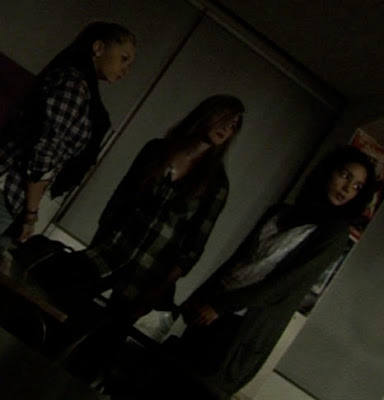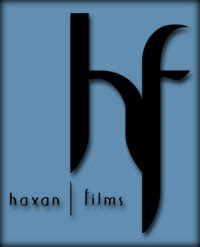In what ways does your media product use, develop or challenge forms and conventions of real media products?
Use of Conventions
When forming my initial ideas - to produce a teaser trailer in the Horror genre - I decided that my trailer would adhere to most of the conventions of horror genre. This was because since the release of the Blair Witch Project in 1999, there has been an increase in films shot using amateur or the "shaky camera effect" style and it was important to conform to the shooting methods to create this style of film Therefore, the majority of the trailer is shot without the aid of a tri-pod to form the hand-held effect and give it a non-professional feel. A teaser trailer is used to build up the audiences awareness and curiosity about the upcoming release of a film. It is shorter in length than the main trailer and depending on the genre has a faster pace. Teaser trailers use quick cuts to create interest; in that the short duration of each shot allows the director to include many pieces of action. Furthermore, the abstract nature of a teaser trailer means that the audience is never quite sure what is happening and therefore may feel compelled to see the film. In relation to conventions of a genre people often only refer to plot and narrative, where as there are technical codes to considers. A problem that I encountered was introducing the quick cuts out of context too early, without enough establishing shots. I therefore added in some scenic pans of the school grounds before the quick cuts to build up tension.
This also worked to establish setting and so helped to orientate the viewer whereas the fast paced, abstract shots disorientated and intrigued them.
This also worked to establish setting and so helped to orientate the viewer whereas the fast paced, abstract shots disorientated and intrigued them.

Development of Conventions
Horror films usually have a mixed group of characters, both male and female, from all demographic backgrounds. I decided to have an all female cast, to represent an all girls school as well as subvert the stero typical concept of the 'male hero'. Horror films have male characters to protect the defenceless "damsel in distress ". However, my characters have no men to hide behind and the main protagonist is neither strong or a leading figure: she is represented as an ordinary teenager in a frightening situation and is not extrordinary in any sense.
The Cultivation Theory althought usually applies to television suggests that by exposing the viewer over time cultivates and altures their parceptions on particular aspects of reality. The same can be occur in film genres. The audience will get an particular impression of the characters that may well be a negative portrayal, so leading to stereotyping. Within the horror genre you can get very stereotypical characters, for example, the 'dumb' or enigmatic blonde, which Hitchcock frequently used in his films and the overbearing and domineering monster/psycho. I would adhere to the conventions of the characters in a "teen-slasher": the idea of screaming victims convayed throught lots of runnin g shots. On the other hand contemporary films do focus a lot more on researching the peoples' backgrounds to produce a much more realistic portrayal of the characters they aim to construct. However, Yet I wanted the protagonists to also portray 21 century teenagers in a modern school to subvert the stereotypes of today's youth. Therefore their sartorial codes are quite casual and they are not portrayed as "sluts" "chavs" or "rude-girls", which are commonly associated with girls of this generation. Although, like many horror films, the persona and realism of the characters is less of a priority and the creation of a sense of horror and terror is more on the agenda.
g shots. On the other hand contemporary films do focus a lot more on researching the peoples' backgrounds to produce a much more realistic portrayal of the characters they aim to construct. However, Yet I wanted the protagonists to also portray 21 century teenagers in a modern school to subvert the stereotypes of today's youth. Therefore their sartorial codes are quite casual and they are not portrayed as "sluts" "chavs" or "rude-girls", which are commonly associated with girls of this generation. Although, like many horror films, the persona and realism of the characters is less of a priority and the creation of a sense of horror and terror is more on the agenda.
 g shots. On the other hand contemporary films do focus a lot more on researching the peoples' backgrounds to produce a much more realistic portrayal of the characters they aim to construct. However, Yet I wanted the protagonists to also portray 21 century teenagers in a modern school to subvert the stereotypes of today's youth. Therefore their sartorial codes are quite casual and they are not portrayed as "sluts" "chavs" or "rude-girls", which are commonly associated with girls of this generation. Although, like many horror films, the persona and realism of the characters is less of a priority and the creation of a sense of horror and terror is more on the agenda.
g shots. On the other hand contemporary films do focus a lot more on researching the peoples' backgrounds to produce a much more realistic portrayal of the characters they aim to construct. However, Yet I wanted the protagonists to also portray 21 century teenagers in a modern school to subvert the stereotypes of today's youth. Therefore their sartorial codes are quite casual and they are not portrayed as "sluts" "chavs" or "rude-girls", which are commonly associated with girls of this generation. Although, like many horror films, the persona and realism of the characters is less of a priority and the creation of a sense of horror and terror is more on the agenda.Challenging Conventions
I did not set out to challenge any of the conventions of the real media products. My aim was to demonstrate the conventions of the genre - cult/horror. In a way I challenged the concept of a mainst ream film by choosing to produce a film, that was initially independent in its style but could cross over and appeal to mainstream audiences. I wanted my film to have independent qualities, as dictated by the budget and production values, but break into the mainstream audience through it unusual filming techniques, narrative and promotional campaigns. The teaser trailer would be produces by Haxan Films as they produce classic independent cult horror films and have a very successful marketing operation. They are attached to Artisan Entertainment which was bought by Lionsgate in 2003. Therefore the production would get the benefits of being apart of a large production company and distributor. Click here for more information. The narrative of the film is important I tried to generate interest in the storyline by using techniques such as voice-overs and sounds, both diagetic and non-diagetic to increase tension. Teaser trailers are before the main promotional campaign so might not give away a lot of the narrative.
ream film by choosing to produce a film, that was initially independent in its style but could cross over and appeal to mainstream audiences. I wanted my film to have independent qualities, as dictated by the budget and production values, but break into the mainstream audience through it unusual filming techniques, narrative and promotional campaigns. The teaser trailer would be produces by Haxan Films as they produce classic independent cult horror films and have a very successful marketing operation. They are attached to Artisan Entertainment which was bought by Lionsgate in 2003. Therefore the production would get the benefits of being apart of a large production company and distributor. Click here for more information. The narrative of the film is important I tried to generate interest in the storyline by using techniques such as voice-overs and sounds, both diagetic and non-diagetic to increase tension. Teaser trailers are before the main promotional campaign so might not give away a lot of the narrative.
 ream film by choosing to produce a film, that was initially independent in its style but could cross over and appeal to mainstream audiences. I wanted my film to have independent qualities, as dictated by the budget and production values, but break into the mainstream audience through it unusual filming techniques, narrative and promotional campaigns. The teaser trailer would be produces by Haxan Films as they produce classic independent cult horror films and have a very successful marketing operation. They are attached to Artisan Entertainment which was bought by Lionsgate in 2003. Therefore the production would get the benefits of being apart of a large production company and distributor. Click here for more information. The narrative of the film is important I tried to generate interest in the storyline by using techniques such as voice-overs and sounds, both diagetic and non-diagetic to increase tension. Teaser trailers are before the main promotional campaign so might not give away a lot of the narrative.
ream film by choosing to produce a film, that was initially independent in its style but could cross over and appeal to mainstream audiences. I wanted my film to have independent qualities, as dictated by the budget and production values, but break into the mainstream audience through it unusual filming techniques, narrative and promotional campaigns. The teaser trailer would be produces by Haxan Films as they produce classic independent cult horror films and have a very successful marketing operation. They are attached to Artisan Entertainment which was bought by Lionsgate in 2003. Therefore the production would get the benefits of being apart of a large production company and distributor. Click here for more information. The narrative of the film is important I tried to generate interest in the storyline by using techniques such as voice-overs and sounds, both diagetic and non-diagetic to increase tension. Teaser trailers are before the main promotional campaign so might not give away a lot of the narrative. 


No comments:
Post a Comment